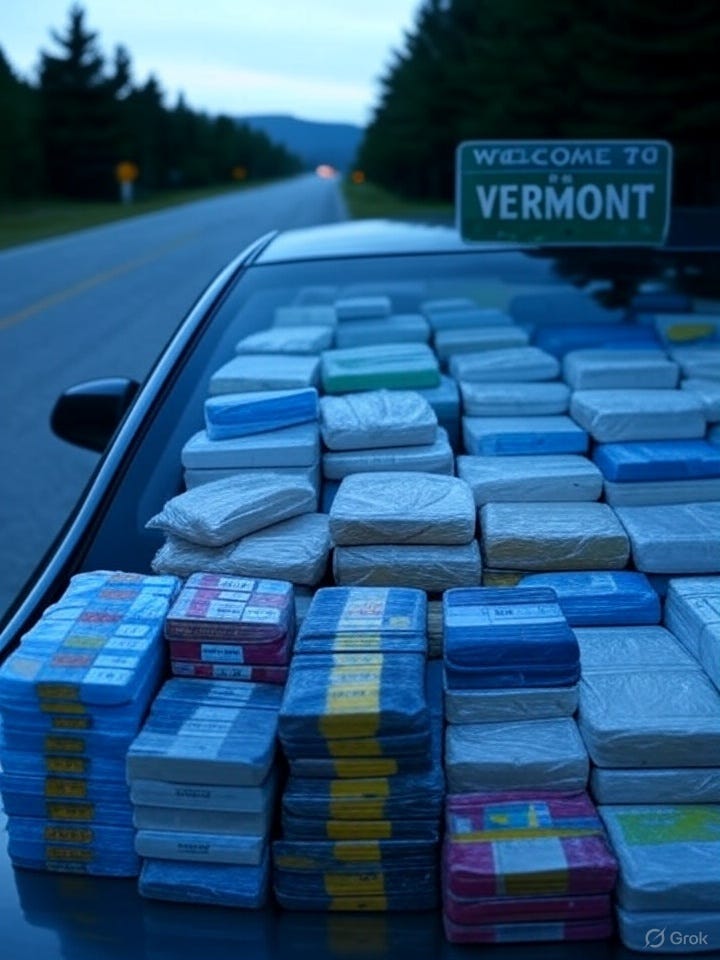Bronx-based traffickers exploit Vermont's focus on harm reduction to flood the market with heroin and fentanyl.
Vermont pours millions into treatment programs to combat the opioid epidemic while lawmakers lock away 15% of opioid settlement funds from a tool that could stem the tide: drug trafficking enforcement
In the shadow of Vermont's rolling hills, an underreported policy decision is perpetuating a deadly cycle. While the state pours millions into innovative treatment programs to combat the opioid epidemic, a little-known rule locks away 15% of opioid settlement funds from the very tool that could stem the tide: drug trafficking enforcement.
This imbalance isn't just a bureaucratic oversight—it's creating a haven for out-of-state dealers, as highlighted in the July 14 New York Times exposé, "The Heroin Pipeline That Linked New York to Vermont," which reveals how Bronx-based traffickers exploit Vermont's focus on harm reduction to flood the market with heroin and fentanyl.
An Expansion Zone for Drug Empires
As Vermont excels at keeping addicts alive through groundbreaking initiatives, critics argue it's inadvertently boosting demand, turning the Green Mountain State into a lucrative expansion zone for drug empires. Vermont's approach to the opioid crisis has earned national acclaim for its emphasis on treatment over punishment.
The state's hub-and-spoke model, which connects specialized clinics with community providers for medication-assisted treatment (MAT), has made it a leader in access to care, with no waitlists and coverage for the uninsured.
Recent allocations from opioid settlement funds—stemming from multibillion-dollar lawsuits against manufacturers like Purdue Pharma and distributors—underscore this priority. For fiscal year 2026, Act 16 (H.218) appropriates approximately $6.5 million from the Opioid Abatement Special Fund to the Department of Health and other agencies, funding syringe services, an overdose prevention center pilot, housing supports, and contingency management programs, according to nashp.org.
Just last month, Governor Phil Scott signed off on over $1 million more for health department efforts, part of a broader $7.4 billion national settlement that Vermont joined in June 2025.
These funds are divided per national agreements: 15% to the state, 70% to abatement strategies, and 15% to local governments (the Subdivision Fund), distributed based on population and impact, which is a federal requirement in most opioid lawsuits.
Vermont Lawmakers Blocked Millions Available for Drug Enforcement
Yet, here's the eye-opener: That 15% local share—discretionary funds meant for municipalities to address the crisis—is effectively barred from bolstering drug trafficking enforcement. Vermont lawmakers and the Opioid Settlement Advisory Committee, which recommends spending, have steered these dollars almost exclusively toward treatment and harm reduction, with no allocations for interdiction, investigations, or task force expansions in recent budgets.
According to WCAX television, Vermont has received $38 million in settlement funds from opioid settlements which could have funded drug trafficking enforcement with an additional $5.7 million to stop the ever-increasing influx of heroin and fentanyl.
This isn't widely publicized; most Vermonters remain unaware, as committee notes from June 2025 focus on recovery associations and health initiatives without mentioning enforcement gaps.
Enforcement Left to Rely on Drying Up Federal Grants
The result? Vermont's Narcotics Investigation Unit (NIU) and Drug Task Force continue to rely heavily on federal grants, like the 2015 award that added investigators but hasn't seen proportional state boosts since.
With enforcement under-resourced, interstate pipelines thrive, as evidenced by fresh cases: In June 2025, a Brooklyn man was sentenced to 47 months for trafficking fentanyl into Vermont, while another New York resident faced charges for similar offenses, according to WCAX television.
Just days ago, the NYT detailed how a single overdose in Rutland unraveled a Bronx heroin network, but such busts are reactive, not preventive, due to funding constraints.
Attracting “Recovery Tourists”
This treatment-first strategy, while humane, creates a perverse incentive. By excelling at overdose reversal and MAT—Vermont ranks first nationally in treating opioid use disorder—it attracts "recovery tourists" from neighboring states like New York and New Hampshire, where access lags.
But without aggressive supply disruption, more addicts mean a bigger market. Dealers from urban hubs see Vermont as low-risk: The state's decriminalization of small amounts of buprenorphine since 2021 and no-arrest policies for overdoses prioritize saving lives over prosecutions, allowing traffickers to expand with minimal interference.
As one June 2025 takedown of a 13-person New York drug network illustrates, these operations pump "poison" into rural areas like Vermont, where enforcement shortages let them flourish.
Settlement Agreements Allow Law Enforcement Expenditures
Critics, including some in law enforcement circles, argue this imbalance sustains the epidemic. Settlement agreements explicitly allow funds for "law enforcement expenditures relating to the opioid epidemic," yet Vermont's choices sideline them, potentially violating the spirit of supplementation over supplantation.
Redirecting even a portion of the 15% local share—estimated at millions annually—could fund additional NIU investigators, border interdiction tech, or HIDTA partnerships, adding resources without cutting treatment budgets, as demonstrated by the New York State Attorney General’s office.
Neighboring states like New Hampshire face similar crises but have debated diverting funds amid budget shortfalls, highlighting the need for balance.
Providing Input to a Potential Shift in Funding
The Opioid Settlement Advisory Committee is seeking local input—which provides an opportunity for Vermonters to push for more enforcement.
Saving lives is noble, but many argue that ignoring the pipeline only ensures more victims. To date, the evidence appears to be on their side.
By locking funds away from busting dealers, a case is being made that Vermont isn't just treating addiction—it's subsidizing the trade.



Enough is enough. Our communities are over-run with drug houses and that count keeps expanding.